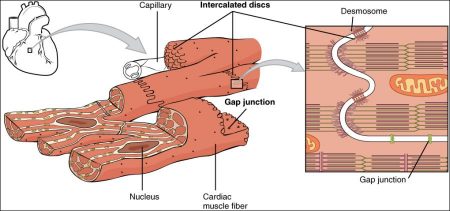Cardiac or heart muscle stands, both structurally and functionally, in an intermediate position relative to the two other varieties of muscle. It is imperfectly striated and branches freely so that there is muscular continuity throughout the atria as one unit and throughout the ventricles as another. In the mammalian heart the atria are separated from the ventricles by a connective-tissue ring. Similar to smooth muscle it is involuntary and contracts rhythmically, irrespective of its extrinsic nerve supply.
It is innervated by the involuntary or autonomic nervous system. All phases of its contraction are more rapid than those of smooth muscles. It is not easily fatigued and a second contraction cannot be elicited before the previous one has run to completion, that is, it is not irritable to its normal stimulus while it is in any phase of contraction. These properties adapt it for the type of work it is designed to perform, namely, the pumping of the blood which must at all times during life be maintained.
Striated muscle
Those muscles which are under the control of the will and in most instances connected with the various bones of the skeletal system and which move the arms, legs, head, and trunk of man are called skeletal, voluntary, or striated muscles, since their most conspicuous structural characteristic is the transverse striation of their fibers.
Hits: 110
